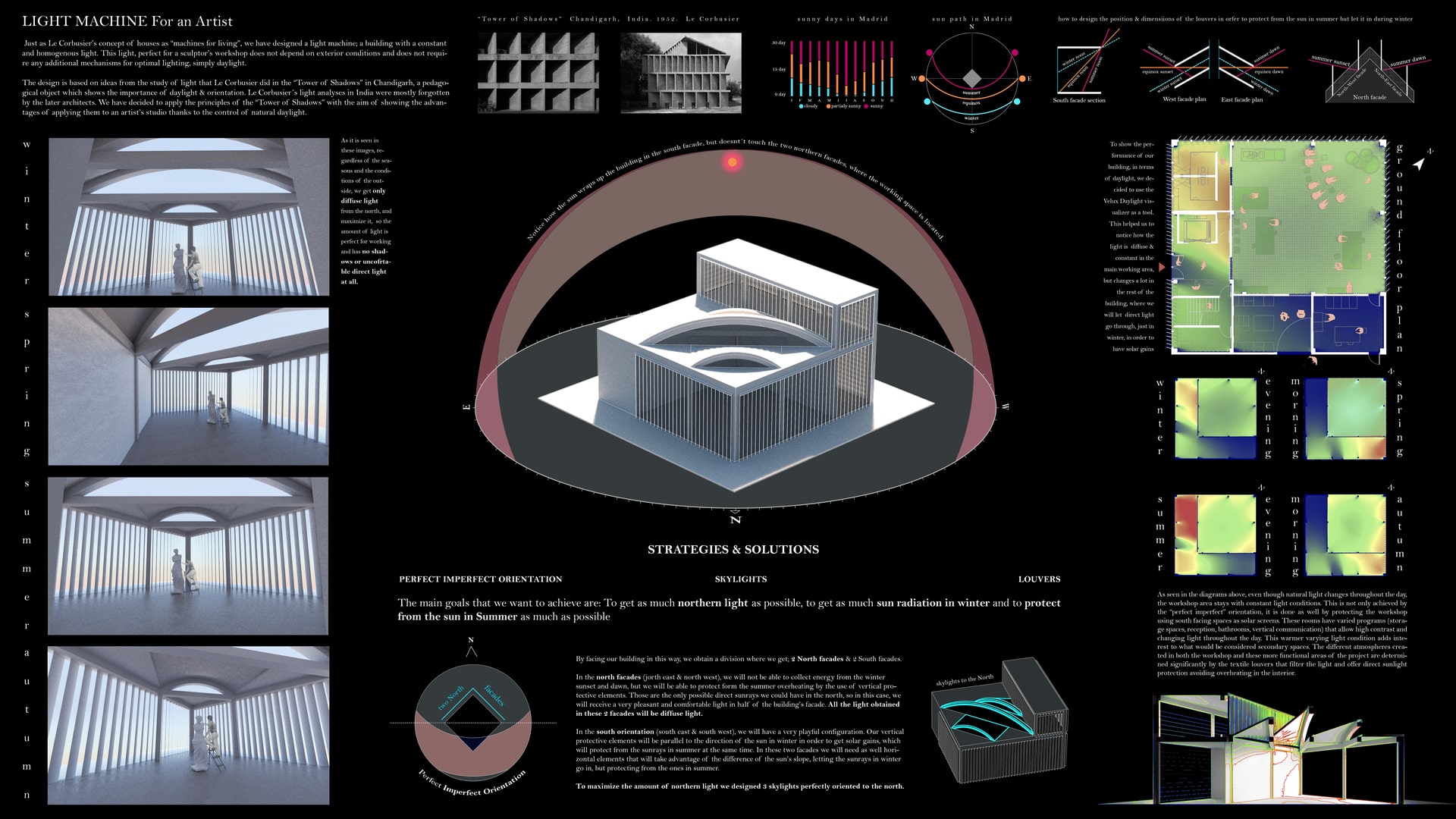Project Description
LIGHT MACHINE For an Artist Just as Le Corbusier’s concept of houses as “machines for living”, we have designed a light machine; a building with a constant and homogenous light. This light, perfect for a sculptor’s workshop, does not depend on exterior conditions and does not require any additional mechanisms, it functions on simply daylight. The design is based on ideas from the study of light that Le Corbusier did in the “Tower of Shadows” in Chandigarh, a pedagogical object which shows the importance of daylight & orientation. Le Corbusier´s light analysis in India were mostly forgotten by the later architects. We have decided to apply the principles of the “Tower of Shadows” with the aim of showing the advantages of applying them to an artist’s studio thanks to the control of natural daylight. Our building is located in Madrid, Spain, close to our university (Universidad Europea de Madrid) and is free of any surrounding, any tall or large structure, giving us the necessary freedom to experiment and play with daylight. We also must take into consideration that Madrid has a significant seasonal thermal oscillation passing from below freezing temperatures in the winter to more than 40ºC in the summer months, which leads to several design decisions that aim to use climatic conditions to create an optimal environment of lighting and temperature throughout the year for absolute comfort in the interior spaces. Madrid’s sunny climate, with almost 2700 hours of sunshine and clear skies, was the main challenge of the project. These conditions are the opposite of what the program requires, which is constant and diffused sunlight. As we are designing a sculptor’s workshop, having great control of the light is crucial. In the working area, large amounts of light are needed. Avoiding direct light to get in is of great importance, as it would create very uncomfortable working conditions and it could potentially damage the sculptures. Taking this into account, our main goals for this project are: - Getting as much diffuse light as possible in the main working area. - Getting as many solar gains as possible in winter & protecting it from the summer overheating. Therefore, our first decision was to place our building in a perfect-imperfect orientation following the form of a rhombus with its vertex oriented to the north. By positioning our building in this way, we obtain a division where we get; 2 North facades & 2 South facades. In the north hemisphere the light from the north is diffused as the sun’s path is in the south. For this reason, we have located our working space facing the north-east and north-west façade, taking advantage of this diffused and constant light. In the south-east and south-west direct sunlight is used during the winter for warming the interior space but avoided in the summer using solar protection.These solar protective elements (louvers) are carefully calculated using Le Corbusier’s reference of the “Tower of Shadows”, taking advantage of the changing solar angle with the seasons. In the North facades (North East & North West), we will not be able to collect energy from the winter sunset or dawn. However, we will be able to protect (it, the rooms, the structure, the interior, the working area) from the summer evening overheating with the use of vertical protective elements. These low-angle east and western rays are the only possible direct sunlight in the spaces facing the north. A very pleasant and comfortable light environment is created in this half of the building where all the natural light is diffused light. On the other hand, in the spaces facing the south (facades facing the south east & south west), we will have a very playful configuration. Our vertical protective elements are parallel to the direction of the winter sunset rays in order to get solar gains in the cold months, while simultaneously protecting the interior from direct sun during the summer. In these two facades, horizontal elements are used for solar protection. These have been designed to allow solar gains during winter months. To maximize the amount of northern light 3 skylights have been designed oriented to the north. Our structure will then be symmetric in the rhombus’s central axis in order to allow these arches to have a perfect north orientation despite the building’s imperfect orientation. The building’s program (storage spaces, reception, bathrooms, vertical communication) surrounding the working area in the south-east and south-west are indirectly used as solar screens that protect the artist’s studio from direct sunlight. This warmer varying light condition adds interest to what would be considered secondary spaces. Using all these strategies, our building provides the perfect light conditions for a sculptor. And as seen in the VELUX daylight visualizer 2, it works as expected, a truly accurate light machine.
